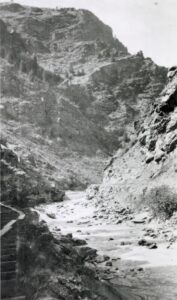Clear Creek: The Heart of Golden
By Stephanie Gilmore
Clear Creek Canyon…The grandest scenery in the mountains, as it twists and turns marvellously (sic), and its stupendous sides are nearly perpendicular, while farther progress is to all appearance continually blocked by great masses of rock and piles of snow-covered mountains.
– Isabella L. Bird, from: A Lady’s Life in the Rocky Mountains, 1879
The Golden History Museum is excited to debut a newly remodeled dual-purpose gallery and meeting room. The Clear Creek Room will house the exhibit, Clear Creek: The Heart of Golden, which will explore the natural, industrial, recreational, Indigenous, and agricultural histories of Clear Creek. With a window that faces the creek itself, this room will also serve as a relaxing meeting space for employees and visitors alike.
Natural Beauty
 The beauty and splendor of Clear Creek has dazzled humans for thousands of years. Without the creek, Golden would not exist. Over the last five million years, cyclical glacial melting and refreezing via numerous ice ages has kept the creek flowing, shaping the landscape. Today, crisp Rocky Mountain snowmelt still flows through the heart of town, carving meanders and deep holes that support rainbow and cutthroat trout, as well as other riparian fauna like the brilliantly colored belted kingfisher and the tiny American dipper, who rely on the water for their diet. Peachleaf willow, narrowleaf cottonwood, and the rare yellow lady’s slipper orchid also call the banks of Clear Creek home.
The beauty and splendor of Clear Creek has dazzled humans for thousands of years. Without the creek, Golden would not exist. Over the last five million years, cyclical glacial melting and refreezing via numerous ice ages has kept the creek flowing, shaping the landscape. Today, crisp Rocky Mountain snowmelt still flows through the heart of town, carving meanders and deep holes that support rainbow and cutthroat trout, as well as other riparian fauna like the brilliantly colored belted kingfisher and the tiny American dipper, who rely on the water for their diet. Peachleaf willow, narrowleaf cottonwood, and the rare yellow lady’s slipper orchid also call the banks of Clear Creek home.
Industry
From smelting and mining to brewing and brickmaking, Clear Creek has a long industrial history. Water from the creek made Golden an ideal spot for industrial pursuits, and the relative flatness of the valley provided easy access for commerce and rail transport. In 1859 prospectors came here in search of gold. While scant gold dust was present in the creek, the true mining value of the area would come in the forms of clay and coal. Smelting, whereby metals are extracted from ore via heating and melting, was another of many industries present here. Later, breweries and flour mills would add their marks to the landscape. While there are no longer active mines here, the legacy of mining remains through the Colorado School of Mines, perhaps the best and oldest mining university in the United States. Coors Brewery, founded in 1873, still produces one of the most popular American beer labels, and in the decades since its establishment, numerous craft breweries have followed suit and settled near Clear Creek.
Recreation
Swimming, kayaking, paddle boarding, fishing, and sunbathing are just some of the popular pastimes on Clear Creek. Tubing has become wildly popular in recent years, enabling Golden’s summer visitors to leisurely float or ride the rapids (depending on water levels) downstream from the mouth of the canyon nearly all the way to downtown. Since 1934, Colorado School of Mines students have used the creek for various recreational activities, including tug-of-war matches and cardboard-boat races during the school’s Engineering Days each spring. Due to the high amount of activity year-round, Golden Fire Department staff uniquely certified in swiftwater rescue practice and train several times per year near the museum.
Native Homelands
Indigenous traditional histories and archaeological evidence indicate that Native people have settled along Clear Creek for millennia. Situated within a unique intersection of alpine, high plains, and riparian ecosystems, the Clear Creek valley is still prized by Native peoples for its clean water, abundant wildlife, herbs, and medicines. A natural conduit between the interior of the Rocky Mountains and the Great Plains, Golden and its surrounding terrain are part of the ancestral homelands of the Núuchiu (Ute), Hinono’ei (Arapaho), and Tsistsistas (Cheyenne), among others. Over 180 plant species in this area have documented Indigenous uses and names, a testament to Clear Creek’s enduring importance for Colorado’s Indigenous community.
Agriculture
The fertile soil along Clear Creek once sustained fruit orchards, grain fields, vegetable crops, and dairy farms. While it is no longer the primary industry in Golden, for over 150 years agriculture was a big business here, from the first European settlement in 1859 through the mid-20th century. Perhaps because little gold was discovered in Clear Creek, early residents of Golden realized that they could turn a profit by supplying food for the mining operations in the nearby foothills. Evidence of the farming industry can be seen in the intricate network of irrigation ditches and reservoirs, some of which still operate today. World War II saw a major decline in farming in this area, and so many farms were replaced with multifamily housing developments.
